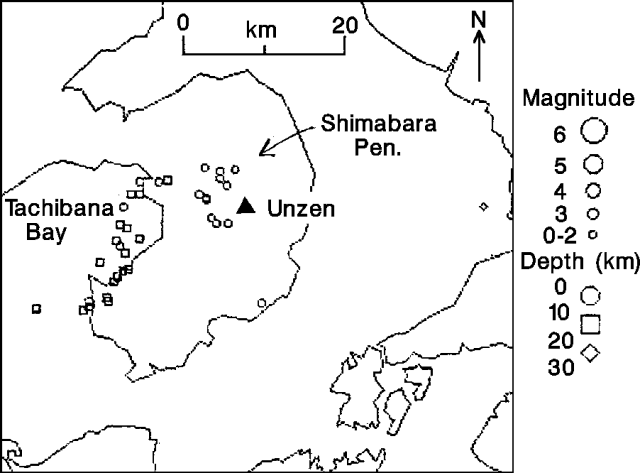Report on Unzendake (Japan) — October 1990
Bulletin of the Global Volcanism Network, vol. 15, no. 10 (October 1990)
Managing Editor: Lindsay McClelland.
Unzendake (Japan) Small gas/ash eruption follows several months of increased seismicity
Please cite this report as:
Global Volcanism Program, 1990. Report on Unzendake (Japan) (McClelland, L., ed.). Bulletin of the Global Volcanism Network, 15:10. Smithsonian Institution. https://doi.org/10.5479/si.GVP.BGVN199010-282100
Unzendake
Japan
32.761°N, 130.299°E; summit elev. 1483 m
All times are local (unless otherwise noted)
Seismicity increased during October, with a monthly total of 549 recorded events (up from 251 in September); 15 shocks were felt 3.9 km SW of the volcano (at UWS). Earthquake swarms occurred on the 17th, 23rd, and 31st, and during the night of 13-14 November, when four shocks were felt at the weather station. Epicenters were located roughly in two groups, one in the central part of the Shimabara peninsula, the other in the sea about 15 km W of the summit (figure 6). The seismicity in the central part of the peninsula was the first there since July. Previous swarms were generally centered at sea.
Tremor resumed on 10 October after 20 days of absence, and as many as 10 episodes/day were recorded through the end of the month. The monthly total of 81 tremor episodes was an increase from 42 in September. Tremor amplitudes were similar to previous months.
Weak, continuous tremor started on seismographs near the volcano at 0322 on 17 November. By dawn (around 0600), an eruption had already begun and residents saw a white plume rising from the volcano; the exact start time of the eruption was unknown. An air and ground survey by JMA and Kyushu Univ revealed that two steam plumes were being continuously erupted from new E flank vents; one was [650] m E of the summit (Fugen-dake), the other about 100 m S of the first vent. The steam plumes were about 300 m high and occasionally contained ash. Weak ashfall was noted downwind. No explosion sounds were heard, and no clear shocks were recorded by seismographs. The amplitude of continuous tremor gradually declined during the day, fading away at around 1900. Steam was still being erupted from one of the vents the next day, and was continuing, but declining, through 19 November. Seismicity was unchanged after the eruption. No damage was reported.
Geological Summary. The massive Unzendake volcanic complex comprises much of the Shimabara Peninsula east of the city of Nagasaki. An E-W graben, 30-40 km long, extends across the peninsula. Three large stratovolcanoes with complex structures, Kinugasa on the north, Fugen-dake at the east-center, and Kusenbu on the south, form topographic highs on the broad peninsula. Fugendake and Mayuyama volcanoes in the east-central portion of the andesitic-to-dacitic volcanic complex have been active during the Holocene. The Mayuyama lava dome complex, located along the eastern coast west of Shimabara City, formed about 4000 years ago and was the source of a devastating 1792 CE debris avalanche and tsunami. Historical eruptive activity has been restricted to the summit and flanks of Fugendake. The latest activity during 1990-95 formed a lava dome at the summit, accompanied by pyroclastic flows that caused fatalities and damaged populated areas near Shimabara City.
Information Contacts: JMA.


